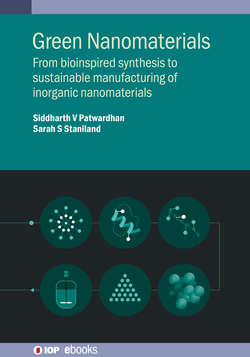Читать книгу Green Nanomaterials - Siddharth Patwardhan - Страница 28
На сайте Литреса книга снята с продажи.
2.4.1.5 Nanosensors in healthcare and medicine
ОглавлениеNanomaterials are ideal sensors because of their very large surface area. Furthermore, because of their small size, they are comparable in scale to many biological targets/disease markers making them particularly useful in biological sensing. Finally, the specific nanoscale properties covered in section 2.2 (particularly optical SPR) are very dependent on subtle chances at the surface of the particles, yielding very sensitive sensors.
Within medical sensoring, the central dogma for the last 50 years has been the use of antibodies raised against a specific biological target to detect that target. Initially in the 1960s this was done with radio labelling of the antibodies and detecting radioactivity. While this is a very sensitive technique, it is not very accessible and has many safety drawbacks. The 1970s saw the development of more accessible immunosorbent techniques such as the enzyme-linked immunosorbent assay (ELISA), where detection is achieved through an antibody attached to an enzyme, which when coupled to its substrate produces a detectible response (usually a definitive colour change). There are many forms of this assay but all use an antibody raised against the target to ‘capture’ the target, and an antibody linked to an enzyme detection system. Different types of ELISA include direct ELISA, where the primary antibody is already functionalised with an enzyme for detection, and sandwich ELISA, which has more steps and uses a primary antibody immobilised on the surface to catch the target and further antibodies to specifically bind to the target. Non-specific antibodies to bind to these which contain the enzyme detection system are then added. One of the best-known examples of ELISA sensing is in healthcare, and is the pregnancy test. This is a sandwich ELISA colorimetric sensor for the pregnancy hormone human chorionic gonadotropin (hCG). The test uses capillary flow to move the analyte (urine) along the test strip and over the immobilised antibodies. Most nanosensors will use antibodies in the form of an immunosorbent assay to target biomarkers and specific proteins, as they are well established, very sensitive, accessible and accurate. However, in recent years there has been a move to use nanoparticles as the detection system instead of enzyme assays, due to potential interactions of the enzyme with the sample and the higher intensity and thus sensitivity of the SPR signal. In this system antibodies can be attached to gold nanoparticles using the strong sulphur–gold bond, by simply adding a cysteine amino acid residue to the antibody. Furthermore, with SPR, there are many more sophisticated improvements that can be made on this simple assay, as this property (outlined in section 2.3.1) is ideally sensitive for nanosensing and can be tuned extensively. Furthermore, much more information, such as spacial information, can be obtained from SPR sensors, which cannot be achieved from simple colorimetric assays.
Increasingly, the SPR light emitted by gold and silver nanoparticles is serving as very sensitive colorimetric detection methods for very small quantities of target. One such target is microRNA (MiRNA). Some of these short strands of RNA are markers for the early signs of some cancers, so would be very useful to detect. However, they are present in very low concentrations. Recent work has used a DNA sandwich assay to detect the specific MiRNA [35]. Here, folded capture DNA containing the complementary sequence to the target MiRNA is immobilised on a gold surface (through a sulphur bond) and unfolds to bind the MiRNA specifically. This subtle change to the surface can be detected by a shift in the SPR signal [35]. Then a gold nanoparticle can be added with more single stranded DNA attached, designed to bind further up the capture DNA only if the MiRNA has bound, and placing the gold nanoparticle in close proximity to the gold surface, greatly enhancing the SPR refractive index signal and changing the resonance angle. This is enhanced further by adding more DNA to create a DNA supersandwich (figure 2.10(A)). This allows detection of MiRNA at concentrations as low as 8 × 10−15 Molar [35].
Figure 2.10. Two examples of ultra-sensitive nanosensors using SPR from gold nanoparticles. (A) A DNA supersandwich assay for the detection of very low concentrations of MiRNA. The numbering on the experimental schematic (top) corresponds to the numbering on the data (below right). A schematic showing how the data is collected from the gold surface is shown below left (adapted from images from [35], copyright 2016, with permission from Elsevier). (B) A molecular ruler measuring the extended distance of hybridising flexible ssDNA to more rigid dsDNA. (i) Example spectral shift between a gold particle pair connected with ssDNA (red) and dsDNA (blue). (ii) Spectral position as a function of time after addition of complementary DNA. Discrete states indicated by horizontal dashed lines (reproduced from [36] with permission of Springer).
When two gold nanoparticles are brought close together, the effect of proximity couples their plasmons, red shifting the SPR peak to larger wavelengths as two gold nanoparticles come closer together and blue shift to smaller wavelengths as they move apart. This phenomenon can be used to sense and measure tiny distances and form a time resolved molecular ruler (figure 2.10(B)) [36]! Here the DNA is attached to one nanoparticle, thus a sulphur linker, while the other end is functionalised with biotin which allows it to bind to the streptavidin coated nanoparticle. A shift from green to orange particles is immediately seen on this coupling. The molecular ruler could be used to measure the effect of hybridising the single-stranded DNA (ssDNA) to double-stranded DNA (dsDNA) (figure 2.10(B)) [36].
